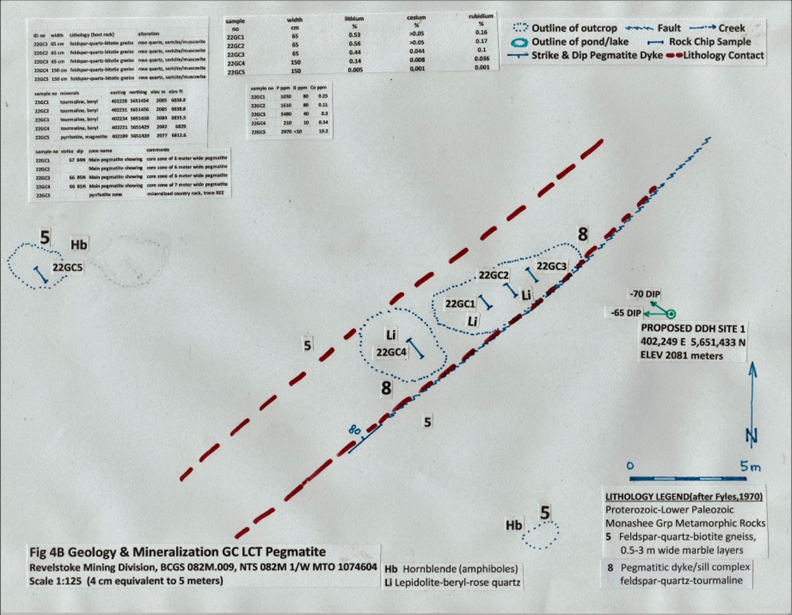INTERESTING In 2022 MGX performed " 5 chip samples on, GC Claims.
In 2023 they sent away more " sample rock " from first 2 GC
samples to be retested using better methods...
2022 - 5 original samples used Aqua Regia
(ME-MS41) 2023 - retakes used
ME-MS89L (super trace DL Na2O2 by ICP-MS) The better assaying practically doubled % values
CS
Li
Rb

This image below depicts the proposed drill site
Hard to say if it's targeting the chalky pegmatites,
or.... grey rock or feldspars... all depends on how the GEO
labels what they deem pegmatite which can vary in,
different mineral composition - had the lake been drawn in
hand drawn photo - i'd be able to triangulate drill locaton.

The image above does lend the impression the samples were
taken in the main - chalky pegmatite zone.
But.... photo # 2 below... has me second guessing...
All because it dones a good sized rock sample + measuring / tape.
Where = Geey silica rock which has the green and blushing red hues.

Did you know an - XRF - can detect Rubidium ?
Yes, indeed it can.
The unique assets of high-resolution wavelength dispersive
X-ray fluorescence (HR-WDXRF) make it possible to measure the atomic structure of various Rb compounds, which allows researchers to improve their knowledge of several atomic and fundamental parameters. The study of energy shifts with curved crystals provides a good opportunity to improve the performance of wavelength dispersive methods. In this work, unusual energy shifts have been measured for RbI, RbBr, RbCl and RbNO
3 in the L spectral lines.
https://pubs.rsc.org/en/content/articlelanding/2020/ja/d0ja00063a OTHER RUBIDIUM INFO The alkali metal Rb is an abundant element in the Earth's crust, although its measured concentration was <1% of the potassium concentration. Geochemically it is closely related to potassium and due to the similar ionic radii, it can substitute potassium in minerals (Ngrel et al., 2018). Since rubidium and K behave very similarly in solutions and on adsorptive surfaces, the results are not surprising.
https://www.sciencedirect.com/science/article/pii/S001670611831214X I'd love to know exactly where the samples were taken using
actual photo images - were any samples taken near the measuring tape ?
For all i know....rhe Geo could be classifying the orangy/felds and
grey ( red/green ) silica quartz pegmatites...right ?
Imagine actually knowing how the - rubidium - presents itself
on the GC claims, grey, red, green...?
Imagine if....the junior took a day and found this answr ?
Imagine scoping all the zones with an XRF finding the highest
Rb zones ?
I wonder if...the larger diameter drill program ( location ) would be changed ?
Hence...using the portable drill method would be ideal...
Use XRF find 25-50 Rb locations....
Then use the portable drill...for each even upto 20m...
Such would reset the tone for this stock.
Cheers....